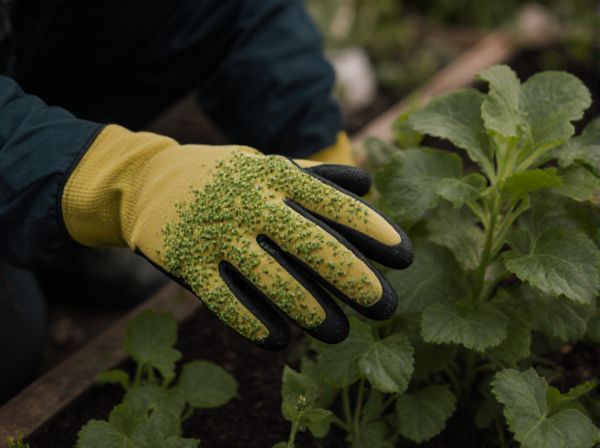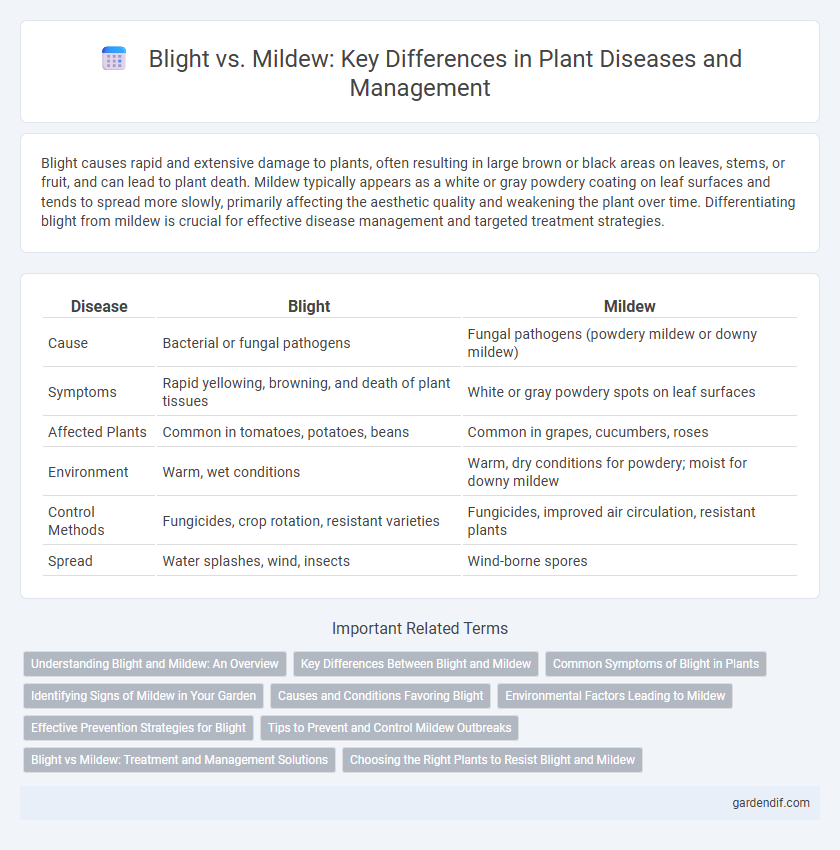
Blight vs Mildew Illustration
Blight causes rapid and extensive damage to plants, often resulting in large brown or black areas on leaves, stems, or fruit, and can lead to plant death. Mildew typically appears as a white or gray powdery coating on leaf surfaces and tends to spread more slowly, primarily affecting the aesthetic quality and weakening the plant over time. Differentiating blight from mildew is crucial for effective disease management and targeted treatment strategies.
Table of Comparison
| Disease | Blight | Mildew |
|---|---|---|
| Cause | Bacterial or fungal pathogens | Fungal pathogens (powdery mildew or downy mildew) |
| Symptoms | Rapid yellowing, browning, and death of plant tissues | White or gray powdery spots on leaf surfaces |
| Affected Plants | Common in tomatoes, potatoes, beans | Common in grapes, cucumbers, roses |
| Environment | Warm, wet conditions | Warm, dry conditions for powdery; moist for downy mildew |
| Control Methods | Fungicides, crop rotation, resistant varieties | Fungicides, improved air circulation, resistant plants |
| Spread | Water splashes, wind, insects | Wind-borne spores |
Understanding Blight and Mildew: An Overview
Blight and mildew are fungal diseases that severely impact plant health and crop yield. Blight causes rapid tissue death, often resulting in dark lesions and extensive leaf, stem, or fruit damage, whereas mildew primarily affects the surface with powdery or downy fungal growth. Effective management requires accurate identification, as blight tends to spread aggressively, while mildew favors humid conditions and surfaces for colonization.
Key Differences Between Blight and Mildew
Blight primarily affects leaves, stems, and fruits, causing rapid and extensive tissue death, while mildew mainly targets leaf surfaces, producing powdery or downy fungal growth. Blight symptoms appear as large, irregular brown spots and can lead to complete plant collapse, whereas mildew causes white or grayish patches without immediate necrosis. The pathogens responsible for blight are often bacteria or fungi, in contrast to mildew, which is predominantly caused by specific fungi from the Erysiphales or Peronosporales orders.
Common Symptoms of Blight in Plants
Blight in plants typically presents with rapid discoloration and wilting of leaves, often accompanied by browning or blackening of stems and roots, leading to tissue death. Lesions may appear water-soaked or necrotic, spreading quickly across foliage and causing foliage blight or stem blight. Common symptoms also include premature leaf drop and dieback, severely impacting plant health and crop yield.
Identifying Signs of Mildew in Your Garden
Mildew in your garden appears as white, powdery spots on the surface of leaves, stems, and buds, often spreading rapidly under humid conditions. The affected leaves may become distorted, yellow, and eventually drop prematurely, weakening the overall plant health. Early identification through these signs helps in timely treatment, preventing widespread damage to flowers, fruits, and vegetables.
Causes and Conditions Favoring Blight
Blight is primarily caused by fungal pathogens such as Alternaria and Phytophthora species that thrive in warm, moist environments with poor air circulation. Conditions favoring blight include high humidity, frequent rainfall, and prolonged leaf wetness, which create an ideal environment for rapid fungal growth and infection. Unlike mildew, blight often results in widespread tissue death, making early identification and management crucial to prevent crop loss.
Environmental Factors Leading to Mildew
Mildew thrives in warm, humid environments with poor air circulation, often developing on plants during prolonged periods of dampness or after heavy rainfall. High moisture levels on leaf surfaces create ideal conditions for fungal spores to germinate and spread rapidly. In contrast to blight, which can be triggered by a wider range of environmental stresses, mildew specifically requires consistent humidity and limited airflow to infect and proliferate effectively.
Effective Prevention Strategies for Blight
Blight prevention focuses on selecting resistant plant varieties, maintaining proper plant spacing for air circulation, and ensuring consistent watering practices to avoid leaf wetness. Removing and destroying infected plant debris reduces fungal spores that cause disease spread. Applying appropriate fungicides at early disease detection stages can effectively control blight outbreaks in crops like tomatoes and potatoes.
Tips to Prevent and Control Mildew Outbreaks
Prevent mildew outbreaks by ensuring proper air circulation and reducing humidity in affected areas, especially in greenhouses and gardens where plants are densely packed. Apply preventative fungicides such as sulfur or potassium bicarbonate at the first sign of mildew to inhibit spore germination and spread. Regularly removing infected plant material and maintaining balanced watering practices helps weaken mildew establishment and control disease progression.
Blight vs Mildew: Treatment and Management Solutions
Blight treatment emphasizes removing infected plant parts promptly and applying systemic fungicides such as chlorothalonil or copper-based products to halt pathogen spread. Mildew management relies on improving air circulation, reducing humidity, and using sulfur or potassium bicarbonate sprays to control fungal growth. Both diseases require regular monitoring and cultural practices like crop rotation and resistant plant varieties to minimize recurrence and maintain plant health.
Choosing the Right Plants to Resist Blight and Mildew
Selecting disease-resistant plant varieties significantly reduces the risk of blight and mildew infections, with cultivars such as blight-resistant tomatoes and mildew-resistant grapes proving effective in disease management. Proper plant spacing and ensuring adequate sunlight exposure strengthen plants' natural defenses against fungal pathogens. Incorporating crop rotation and resistant rootstocks further minimizes the presence of blight and mildew-causing organisms in the soil.
Blight vs Mildew Infographic

 gardendif.com
gardendif.com